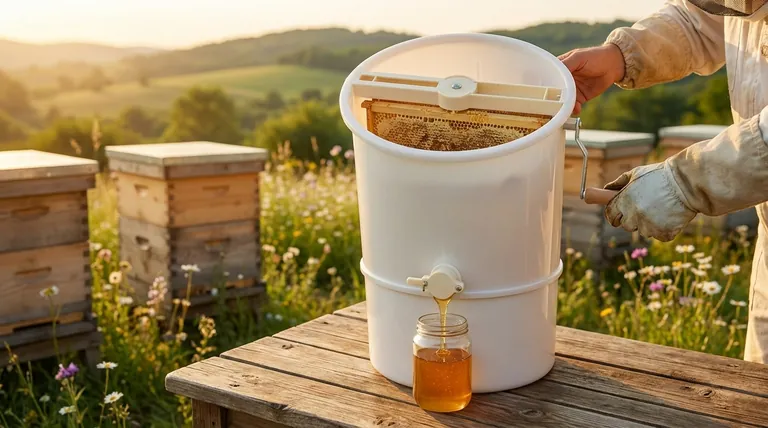The primary advantages of a manual honey extractor are its lower cost, operational simplicity, and complete independence from electricity. This makes it a highly accessible and reliable tool, offering the beekeeper precise control over the extraction speed without the complexity or expense of a motorized unit.
The decision between a manual and an electric extractor isn't about which is "better," but which tool aligns with your scale of operation. A manual extractor is the superior choice for hobbyists and small-scale beekeepers, while an electric model is a necessity for commercial ambitions.

The Core Benefits of Manual Extraction
A manual extractor provides a series of distinct advantages that make it the ideal choice for a specific type of beekeeper. These benefits center on cost, control, and simplicity.
Significant Cost Savings
A manual extractor represents a much lower initial investment compared to its electric counterpart. This makes it the most budget-friendly entry point for new beekeepers or those with a limited number of hives.
Complete Independence from Power
Because they operate with a simple hand crank, manual extractors can be used anywhere. This is a critical advantage for apiaries in remote locations or for those aiming for an eco-friendly, off-grid setup.
Unmatched Control Over Speed
The user directly controls the rotational speed by turning the crank. This allows for a gentle start, which is crucial for protecting delicate new combs from being destroyed by sudden, high-speed force.
Simplicity in Operation and Maintenance
With fewer complex parts and no motor, manual extractors are straightforward to use and easier to maintain. Cleaning and troubleshooting are typically much simpler processes.
Quiet and Portable Operation
Manual extractors are significantly quieter than electric models, making the extraction process a more peaceful experience. Their simpler construction also often makes them lighter and more portable.
Understanding the Trade-offs: Labor and Scale
The clear advantages of a manual extractor come with equally clear trade-offs. These limitations are not failures of the tool but rather defining characteristics that make it unsuitable for larger operations.
The Demand for Physical Effort
The most significant drawback is the physical labor required. Extracting honey, especially from more than one or two hives, is a time-consuming and strenuous workout that requires consistent manual cranking.
Slower Processing Time
Manually cranking each batch of frames is inherently slower than flipping a switch. This is a non-issue for a hobbyist but becomes a major productivity bottleneck for any beekeeper with a significant number of frames to process.
Limitations for Growing Apiaries
These extractors are purpose-built for small-scale beekeepers. If you manage more than a handful of hives or plan to expand, the time and labor required will quickly outweigh the initial cost savings.
Making the Right Choice for Your Apiary
Choosing the right equipment is about honestly assessing your goals, physical capacity, and the scale of your operation.
- If your primary focus is keeping a few hives as a hobby: A manual extractor is the most logical and cost-effective choice.
- If your primary focus is beekeeping in a remote or off-grid location: A manual extractor is your most reliable, and often only, option.
- If your primary focus is growing a commercial or large sideline business: The labor and time required for a manual extractor will hinder your productivity; an electric model is a necessary investment.
By aligning your equipment with the scale of your passion, you ensure the harvest remains a reward, not a burden.
Summary Table:
| Advantage | Description |
|---|---|
| Cost Savings | Lower initial investment, ideal for budget-conscious beekeepers. |
| Power Independence | Operates anywhere with a hand crank, perfect for remote apiaries. |
| Speed Control | Gentle, user-controlled cranking protects delicate honeycombs. |
| Simplicity & Maintenance | Fewer parts, easier to clean and maintain than electric models. |
| Quiet & Portable | Peaceful operation and easy to transport. |
Ready to choose the right extractor for your apiary?
HONESTBEE supplies high-quality beekeeping supplies and equipment, including manual and electric honey extractors, to commercial apiaries and beekeeping equipment distributors through our wholesale-focused operations. Our experts can help you select the perfect equipment to match your scale and goals, ensuring your harvest is efficient and rewarding.
Contact HONESTBEE today for a personalized consultation and wholesale pricing!
Visual Guide

Related Products
- Plastic Hand Crank 2 Frame Honey Extractor Low Price
- 6 Frame Manual Stainless Steel Honey Extractor Beekeeping Equipment
- 2 Frame Stainless Steel Manual Honey Spinner Extractor for Beekeeping
- HONESTBEE 3-Frame Manual Acrylic Honey Extractor
- Automatic Honey Frame Uncapper Machine for Beekeeping
People Also Ask
- Can honey be harvested from frames with brood? The Critical Rule for Healthy Bees & Pure Honey
- Why are manual extractors popular among beginner beekeepers? A Guide to Starting Simple & Saving Money
- What tips can maximize honey extraction efficiency? Unlock Higher Yields and Purer Honey
- What are the general precautions to take when extracting honey? Ensure a Safe, Efficient Harvest
- What equipment is used for honey harvesting? Build Your Perfect Harvesting Toolkit



















